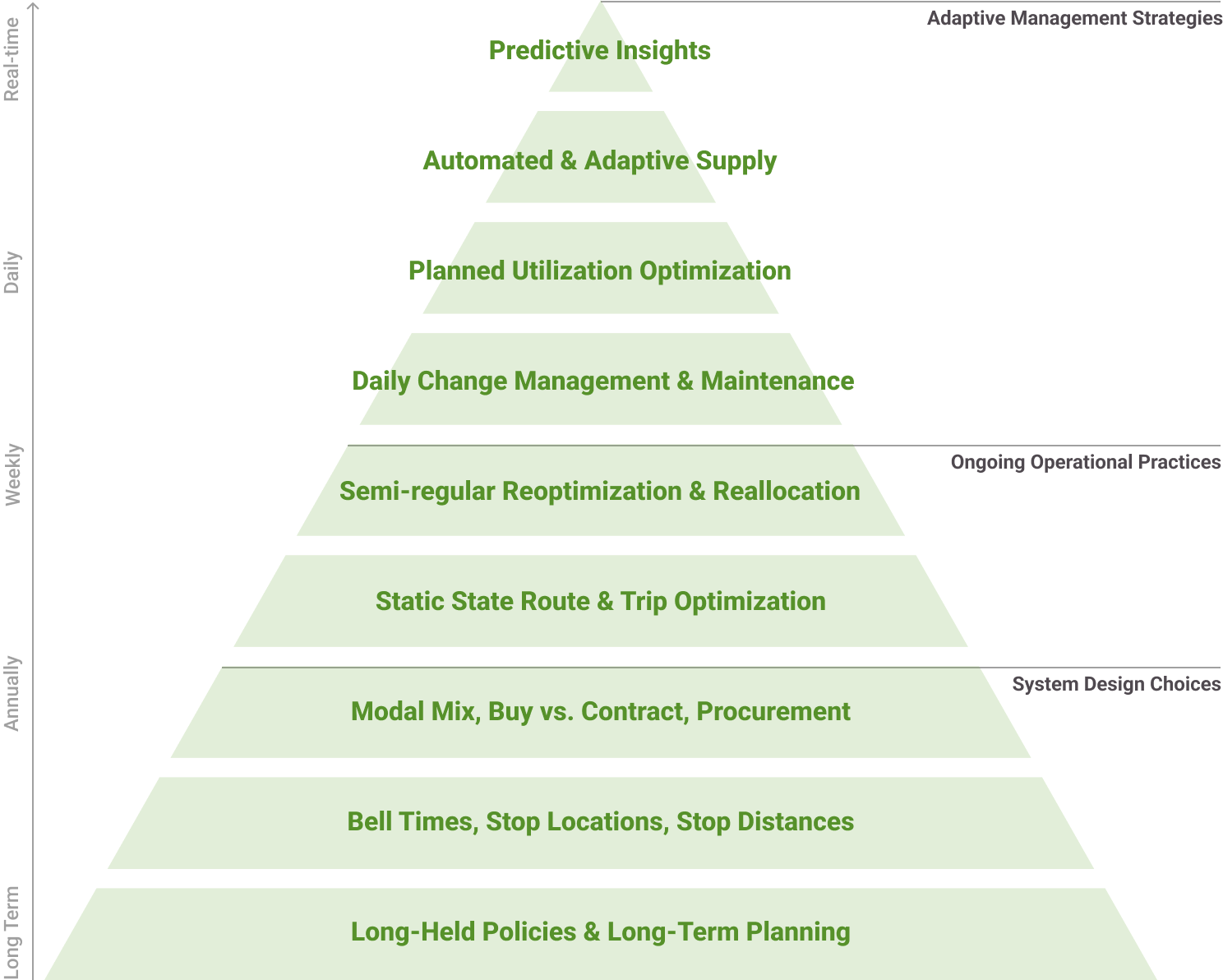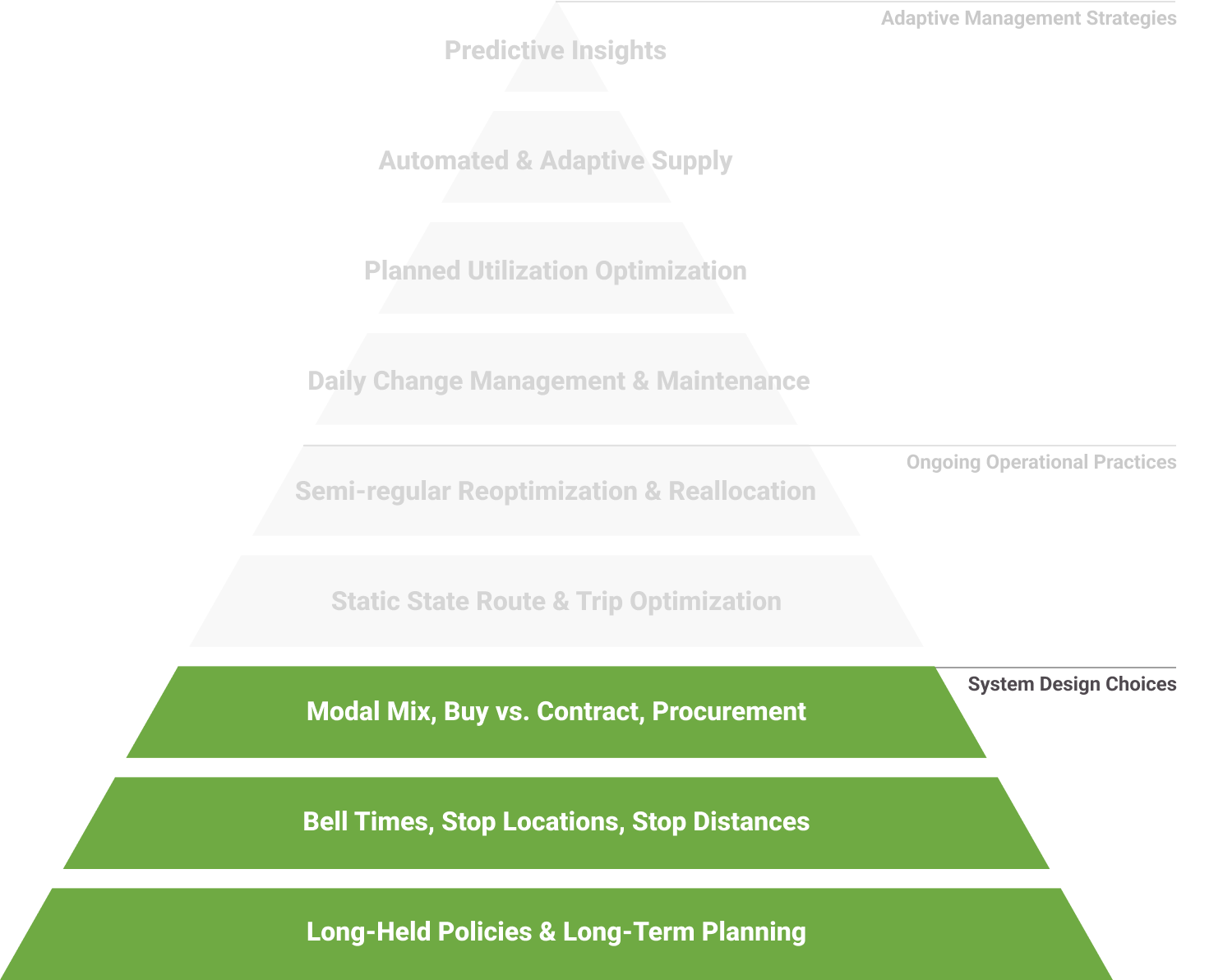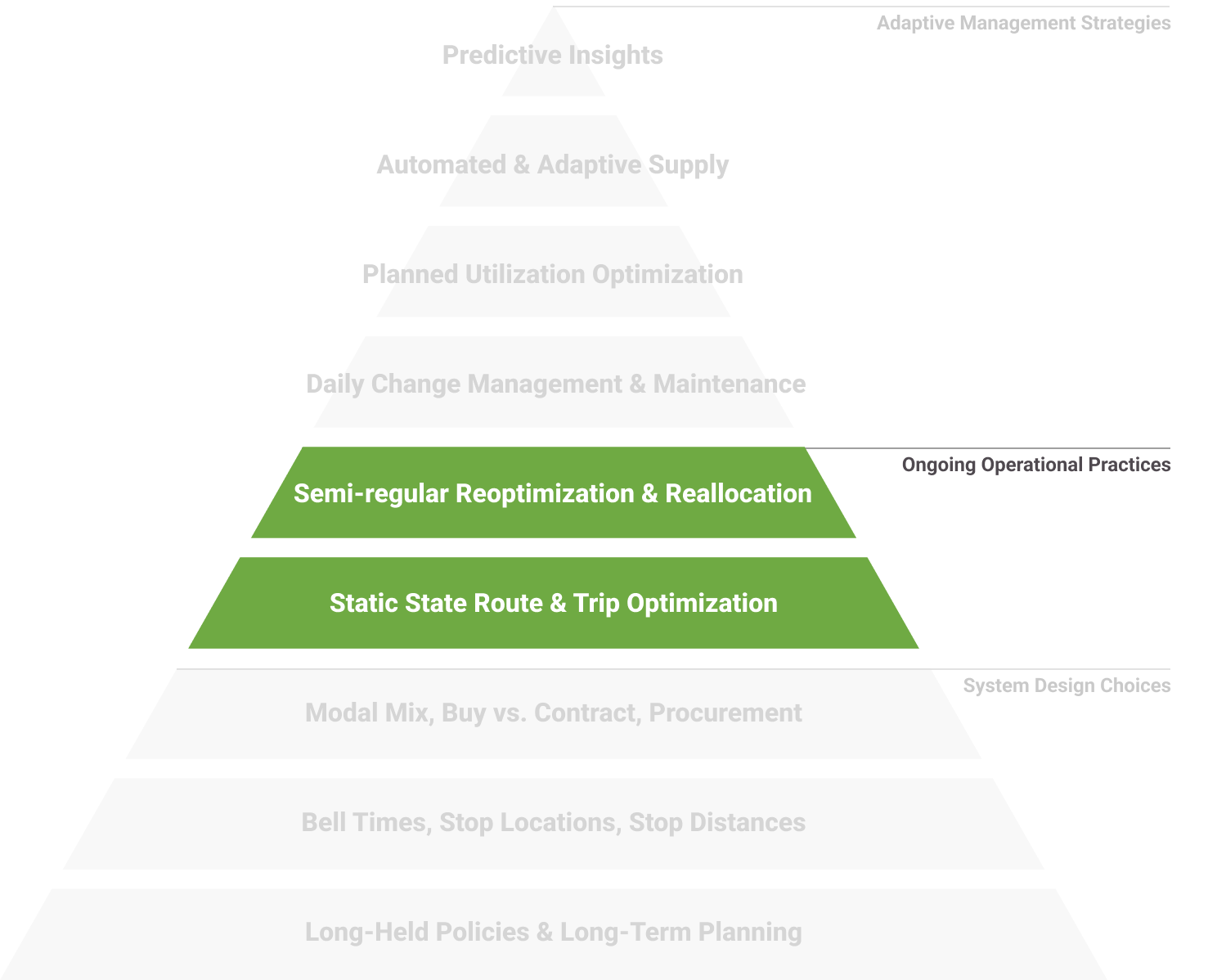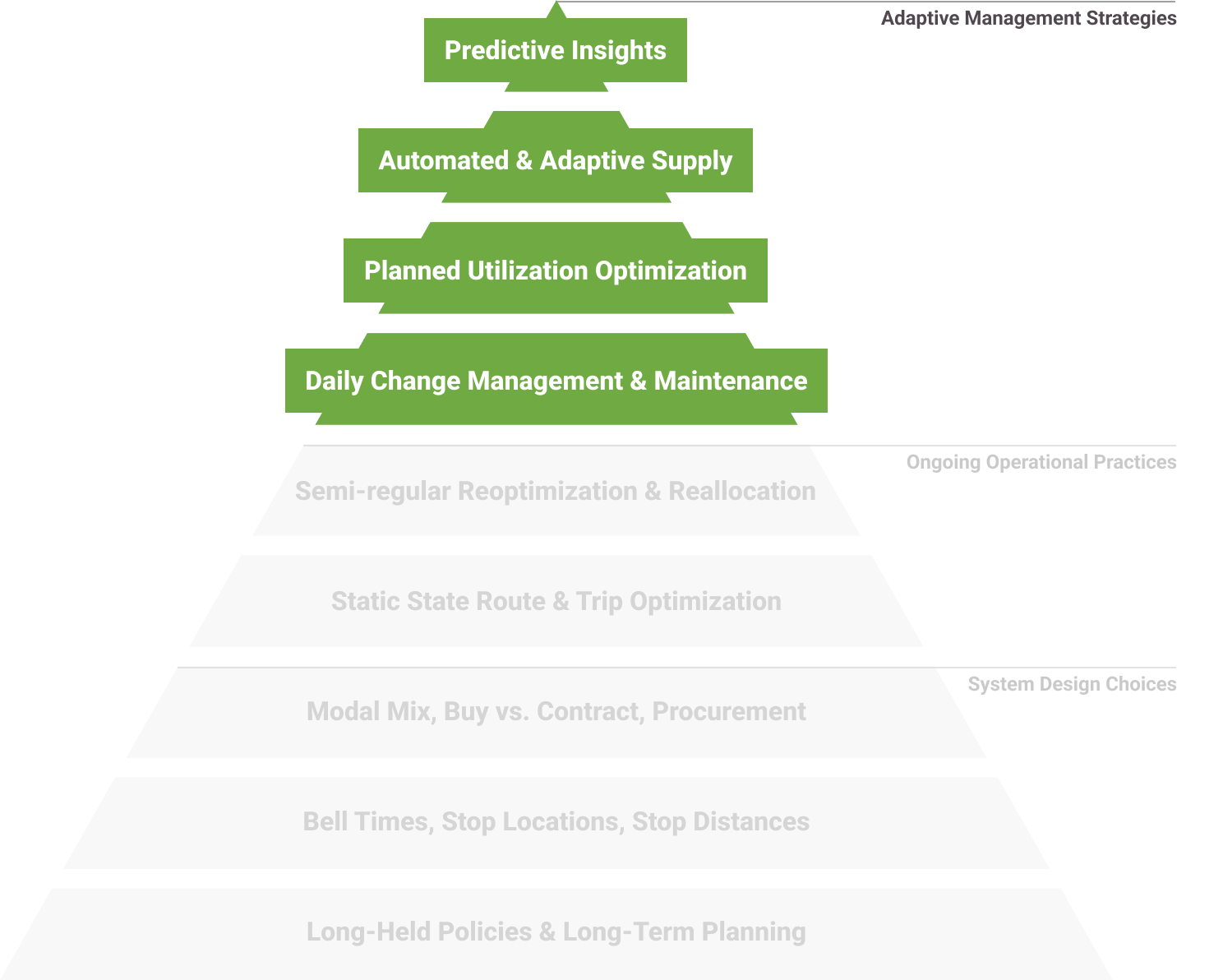The Student Mobility Efficiency Pyramid

4MATIV’s efficiency framework summarizes crucial system design choices and levers for containing costs and driving efficiencies. The efficiency framework outlines three broad categories that impact the efficiency and effectiveness of a transportation system:
-
System Design Choices
-
Ongoing Operational Practices
-
Adaptive Management Strategies
In general, while most school systems focus on the bottom layers of the pyramid (system design choices), they struggle to make meaningful change, they are overly reactive or inconsistent at responding to the middle layers (ongoing operational practices), and few have the tools to take action at the top (adaptive management strategies).

Establish a Strong System-Level Base
At the bottom of the efficiency pyramid are system design choices: the long-held, hard-fought district and system decisions that may be reviewed and revised every few years, or sometimes less frequently. Examples include choices like facilities planning, drawing eligibility boundaries, and rethinking school locations. Policy changes at this level have the largest impact because they determine who is transported in the first place and what efficiencies are possible higher up the pyramid. However, they can also be the most difficult to implement because instead of simply purchasing new equipment or adopting a new technology, system design changes require political will and expend political and community capital. State law typically establishes minimums for the geographies and students systems are required to serve, but most often systems at baseline offer far more service than what is minimally required.
A bit easier to alter—but still huge levers for creating efficiency—are school bell times, bus stop locations, the modal mix, and network practices. Consider school bell times, which do not change very often. If a district adopts a two-tiered bell-time model where one set of schools starts at 7:30 AM and another set starts at 9:00 AM, and if routes are perfectly paired to maximize trip utilization and if each vehicle maximizes seat utilization given the large window between bell times for picking up students, the school system can reduce its vehicle and driver needs by half compared to a single tiered system. Likewise, school system policies typically allow for a reasonable distance between students’ homes and their assigned bus stops, but transportation department and operator practices are often far more accommodating. A thoughtful reevaluation of stop locations and stop distances from student homes can significantly improve the efficiency of the entire system by enabling the design of more direct and denser routes.
Similarly, school systems infrequently change their mix of vehicle sizes and types (e.g. swapping out buses for vans where routes can only accommodate a few students), expand the variety of modes they support (like adding specialized outsourced services, building carpool networks, launching walking school buses, and working with city transit, etc.), or go out to competitive bid for long-term operator contracts. Careful planning, execution, and differentiation of service at this level has dramatic downstream impacts on supply, reliability, and costs.

Effectively Manage Regular Operations
Once the larger system design considerations are in place, maintaining them is critical. To do so effectively, systems need annual and ongoing operational practices in place.
Optimize the Static State
Every year before the school year begins and when things aren’t moving, school systems have a chance to reset the system and start fresh. At this point the school year’s policies are in place and the system is static, allowing transportation planners to re-optimize the transportation plan. At the same time, the system has introduced new students, students have advanced in age and grade level, and many students have left. Additionally, in partnership with Special Education Departments, school nurses monitoring 504 plans, and system staff working closely with students who had been considered homeless in the previous year, many students’ circumstances may have changed – allowing them to be routed on regular bus routes, and making room for students who may need increasing accommodation in the coming year.
This is the time to do all the things that are difficult to do once the school year gets going: consolidate routes where loads have reduced, move and eliminate bus stops as students have aged or moved schools, re-pair trips to minimize deadhead time between trips, and create the most efficient system possible. Without disciplined “spring cleaning” and a mindset to reset each year, school systems tend to simply start each new year with the previous year’s routes and stops as a baseline. Stops in particular tend to be “sticky” year over year, resulting in ever-increasingly accommodating home to stop distances for students even as they get older.
Reoptimize Semi-Regularly
But once the school year begins, most systems undergo a high degree of flux with late enrollees and a backlog of unknown moves or changes of circumstances that bubble up as families return from summer break. Transfers also tend to be front-loaded as the year begins. Furthermore, even the best designed systems need the early weeks of a school year to work out kinks in routes, adjust to processes at schools that are highly variable, and understand actual ridership and new traffic patterns, so naturally routes need some adjustment once the year has started. The system’s initial static state theoretical efficiency can deteriorate and need to be revised.
Four to six weeks into the school year is an ideal time to make bigger moves to solve problems that families and schools might be experiencing and to adjust assignments with drivers. Thereafter, significant revisions to routes, stops, and driver/vehicle assignments can happen week-to-week, but they can also cause disruption to family, school and driver routines. As the volume of performance issues and enrollment or accommodations changes starts to settle, systems should be mindful and hold larger changes like wholesale re-routing to a quarterly cadence.

Solutions to Adapt in Real Time
A student mobility system that is flexible and agile is one that can respond to daily changes, plan short-term solutions, and even use system data and observation to predict what will happen tomorrow or next week. Adaptive management strategies are increasingly necessary as student needs become more complex, families expect personalized and responsive service, and varied learning opportunities proliferate, continuing towards greater unbundling.
Daily Change Management and Maintenance
In many ways schools already wrangle daily changes as they maintain student routes, but they typically get stuck doing so in a reactive way, putting out fires as they show up. Mostly this means accommodating new students and other requests. School systems might even be effective at fixing on-time performance issues, but typically transportation departments are in crisis-mode when they do so, responding to the loudest and most connected or influential parents and school leaders first.
Instead, it’s possible to establish a proactive approach that seeks out opportunities for efficiency on a daily basis. For example, if a system runs yellow buses, it might not matter to the course or performance of a route if a single student stops riding. In fact, the system might not even notice (though drivers likely will). But if a student is the only one using a particular stop, it might create an opportunity for a route to eliminate that stop from the route (commonly referred to as a “dead stop”) and become more streamlined, saving both time and money. These kinds of small daily changes add up, so a transportation team needs a regular process in place to identify these changes and adjust to them. Over the course of several weeks, adjustments might allow rebalancing of route loads to improve on-time performance or even the ability to consolidate multiple trips or routes into one, generating significant savings and freeing up drivers to cover other work.
Planned Utilization Optimization
With better data, systems can see trends in ridership, plan accordingly, and become even smarter. For example, commonly on any given route there are students who don’t ride everyday. So if a route is optimized initially to serve 50 students and only 40 students typically ride each school day, then routes can be “overbooked” with students in excess of the vehicle’s actual capacity added to the planned route knowing that the bus will rarely (if ever) be full. It is critical that school systems assign riders as close to the practical maximum without overloading a route, triggering the provision of an additional vehicle that is expensive, or causing an unsafe or urgent situation with students unable to board or find a seat. But systems that engage in such planning carefully and monitor actual ridership systematically will make better use of their scarce resources and ultimately be able to deliver better service elsewhere.
Indeed, your data might show that three-fourths of students don’t ride home on a given day during the week. Even in these instances, it’s possible to adjust and plan for lower utilization on those days and save resources by not running a bus or running a smaller vehicle for the one-fourth who need it. Freed-up vehicles and drivers could simply take the time off, or could be used for something else like a hard-to-cover field trip or athletic program.
Automated & Adaptive Supply
With the right kind of supply in place, like on-call drivers, variable cost van, taxi or TNC operator-partners, known reductions in demand such as a single student not riding or an entire route not needed for a day or an afternoon can be exploited to save resources in real-time. Such changes can even be automated with trigger notifications sent to key personnel or families so that adjustments can be confirmed and made even more quickly. For example, if ten students didn’t ride buses in the morning, perhaps they also won’t need transportation home. An automated system or staff that has been notified can reach out during the midday period to confirm whether they’ll need the afternoon ride or not. Each one of those decisions saves a seat, every seat saved creates a more efficient route, and when these accumulate (and the system has a flexible and adaptive supply), a bus can be swapped for a van or a van for a taxi, or perhaps an operator’s rate for the day can be reduced.
Predictive Insights
Finally, an advanced system that captures actual ridership and understands the nature of flexible and variable cost supply could identify past patterns and make predictions about the future so a system can adjust ahead of time rather than being reactive. For example, imagine the data shows that every third Tuesday a student doesn’t ride their taxi. We can cancel that ride for the student and prompt the family to notify us ahead of time if the ride is actually needed. While these kinds of changes might feel small, they can accumulate in a large system with complex demand. If systems can therefore adapt, significant efficiencies can be created.
